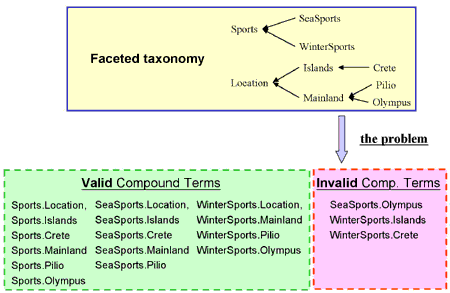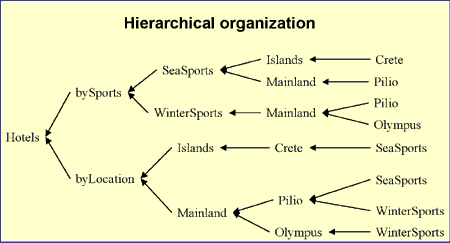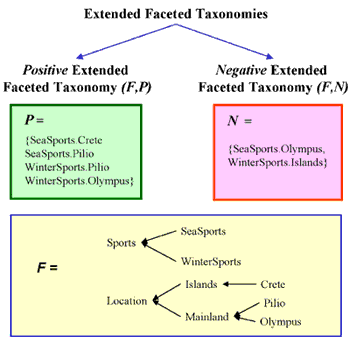 This issue in pdf Archive: |
|
|||||||
Extended Faceted Taxonomies for Web Catalogsby Yannis Tzitzikas, Nicolas Spyratos, Panos Constantopoulos and Anastasia Analyti Which would be easier to remember: one thousand individual terms or three facets of ten terms each? One way of creating a taxonomy for a knowledge domain is by identifying a number of different aspects or facets of the domain and then designing one taxonomy for each facet. Several studies in information, library and cognitive science have shown that in almost every knowledge domain we can indeed distinguish a number of facets, or planes of understanding. A faceted taxonomy is actually a set of taxonomies, called facets, each of which is a set of terms structured by a specialisation/generalisation relation. Using a faceted taxonomy, the indexing of objects is done by associating each object with a compound term, ie with a combination of terms coming from different facets. It was recognised long ago that a faceted taxonomy has several advantages over a single hierarchical taxonomy, including conceptual clarity, compactness and scalability. For example, consider two schemes for indexing the objects of a domain, the first using a single taxonomy consisting of 100 terms, and the second using a faceted taxonomy consisting of 10 facets each having 10 terms. The first scheme has 100 indexing terms while the second has 1010 (10 billion) compound indexing terms! Although both schemes have the same storage requirements, ie each one requires storing 100 terms, the second has tremendously more indexing terms than the first. However, faceted taxonomies have a major drawback that prevents their deployment and use for real and large-scale applications like the Web. This drawback comes from the fact that it is possible to form a large number of invalid compound terms, that is, combinations of terms that do not apply to any object of the underlying domain. For example, refer to the faceted taxonomy for a tourist information application shown in Figure 1 and consider the terms WinterSports from the facet Sports, and Crete from the facet Location. The compound term WinterSports.Crete is invalid, as there is never enough snow in Crete! In contrast, the compound term SeaSports.Crete is certainly valid. The inability to infer the valid compound terms may create problems in object indexing (laborious and/or erroneous indexing), and in browsing (an invalid compound term will yield no objects). Due to such problems, existing Web catalogues have a strictly hierarchical structure like the one shown in Figure 2. Such taxonomies suffer from several problems such as incomplete terminology, huge size (for example the taxonomy of Open Directory consists of 300 000 terms) and confusing structure.
Being able to infer the validity of a compound term in a faceted taxonomy would be very useful for facilitating indexing and for preventing errors, especially in cases where indexing is done by many human editors (indexers). For example, Web pages in the Open Directory are currently indexed by more than 20 000 volunteers. Moreover, if we could infer the valid compound terms in a faceted taxonomy then we would be able to generate navigation trees (like the taxonomies of Web catalogues) on the fly, consisting of nodes that correspond to valid compound terms. However, manually defining the set of valid compound terms even for facets of relatively small size would be a formidable task for the designer. For example, Figure 1 shows the partition of compound terms into sets of valid and invalid terms.
To alleviate this problem, we have defined two extensions of faceted taxonomies, which we call PEFT and NEFT, which allow the specification of valid compound terms in a flexible and efficient manner. A PEFT (Positive Extended Faceted Taxonomy) is a faceted taxonomy enriched with a set P of compound terms known to be valid, while a NEFT (Negative Extended Faceted Taxonomy) is a faceted taxonomy enriched with a set N of compound terms known to be invalid. The designer simply declares a small set of valid or invalid compound terms, and other (valid or invalid) compound terms are then inferred by a mechanism based on semantic implication. Figure 3 shows how we can specify the valid compound terms of the faceted taxonomy of Figure 1, ie the sets 'Valid Compound Terms' and 'Invalid Compound Terms' as enumerated in that figure, by employing either a PEFT or a NEFT. In each case we can dynamically derive a navigation tree such as the one shown in Figure 2 that can be exploited during object indexing and browsing. Our approach can be used for developing Web catalogues that offer complete navigation trees, require less storage space, and are more comprehensive and scalable. Furthermore, taxonomies designed according to our approach can be integrated or articulated more easily than hierarchical ones. Further research includes extending this approach to define an algebraic system for taxonomies with operators that allow the specification of valid compound terms using both positive and negative sets of compound terms. This work is the result of basic research conducted at ICS-FORTH over the last two years. Please contact: |
|||||||




